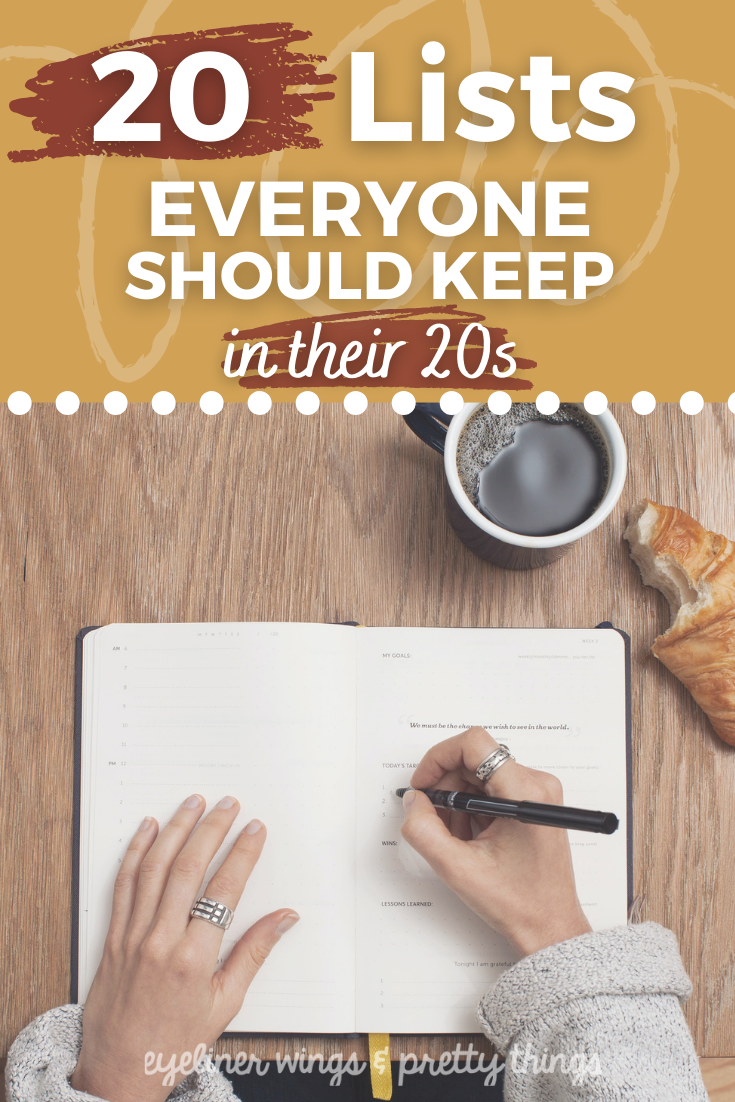
Maybe it’s a result of my combination of poor memory, ESTJ Myer’s Briggs type, and limited attention span, but I love making lists. And I firmly believe there are lists everyone should have in their 20s. They can make your life easier and make you a better, more thoughtful person.
I have a list for just about everything. In fact, this post idea came to mind when I was eating Mallomars (so delicious) and thought I should probably include them on my list of favorite snacks.
Here are ideas for lists I think everyone in their 20s should be making.
List of empties
Remember those monthly “empties” videos that were super popular on YouTube in the 2010s? It’s sort of like that.
I hate running out of things, so keeping a list has made me feel a bit more accomplished about finishing a used-up mascara or tossing a burnt-to-the-base candle. For some, it might also be handy to keep track of spices or crafting supplies.
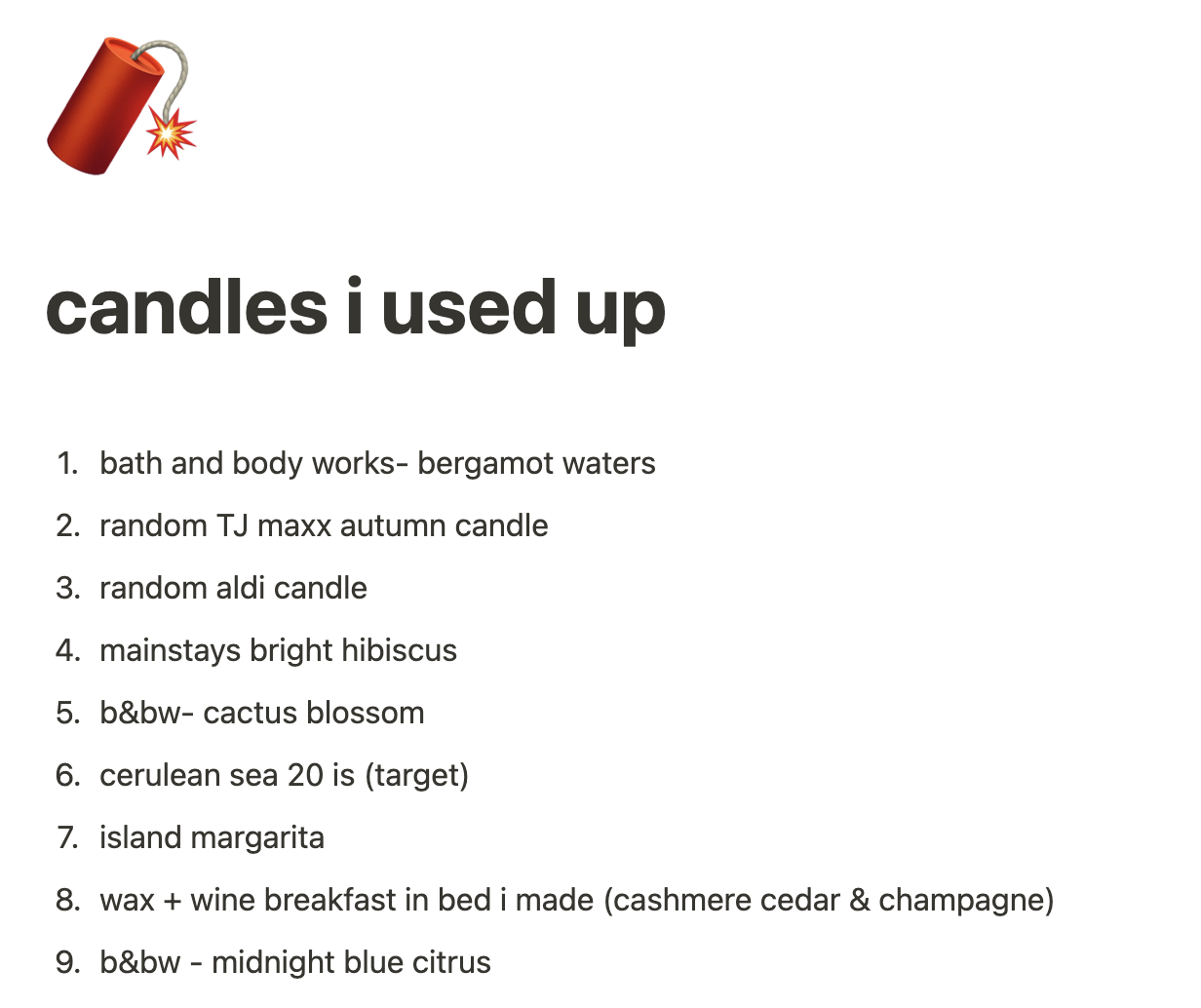
Start with: I keep track of my candles because I like to see which scents I burned throughout the year. I also track my empty skincare and beauty products to see how long it actually takes me to finish them and when I should repurchase them.
Elevate it: Include the cost of products and the dates you finish them to help adjust your annual budget or see how much you’re really spending on certain items. You can also include a rating of the products to remember if you should repurchase them again or not.
Updated stock lists to help when shopping
The pantry in our apartment is great but it’s also a hard-to-navigate, giant pit of half-eaten bags of chips and cans of crushed tomatoes. I noticed that we kept running out of staples without realizing it until it was too late, buying doubles of items we already had, or not using things before they expire.
So I began keeping a list of what we had “in stock” to help us meal plan and grocery shop smarter. This type of list might also be helpful for any other items you find yourself buying regularly, like cleaning products.
Start with: Clean out your pantry, toss expired stuff, and make a list of each item as you put it back in. I like to use the Notes app and share it with my boyfriend so we can both update items we use and see how much of everything we have left.
Elevate it: Put large magnetic dry-erase boards on your fridge. Write down what’s in your freezer and fridge and when it expires. Be sure to include produce and open, partially used things, like red wine or heavy cream. Keeping these lists has really helped us actually use ingredients and meal plan much better.
Archives of anything you collect
I made this list after I noticed I kept accidentally buying the same nail polish. I bought it three times in two months. I also kept accidentally buying books I already owned (so many thrillers look and sound the same on their covers).
Making a giant list of what you have will consume an afternoon, but once you have it it’ll wonderful. Plus, if you make it on Notion, Google Docs, or even your Notes app, it will be searchable. At the store, you can just whip out your phone and do a search to avoid buying doubles.
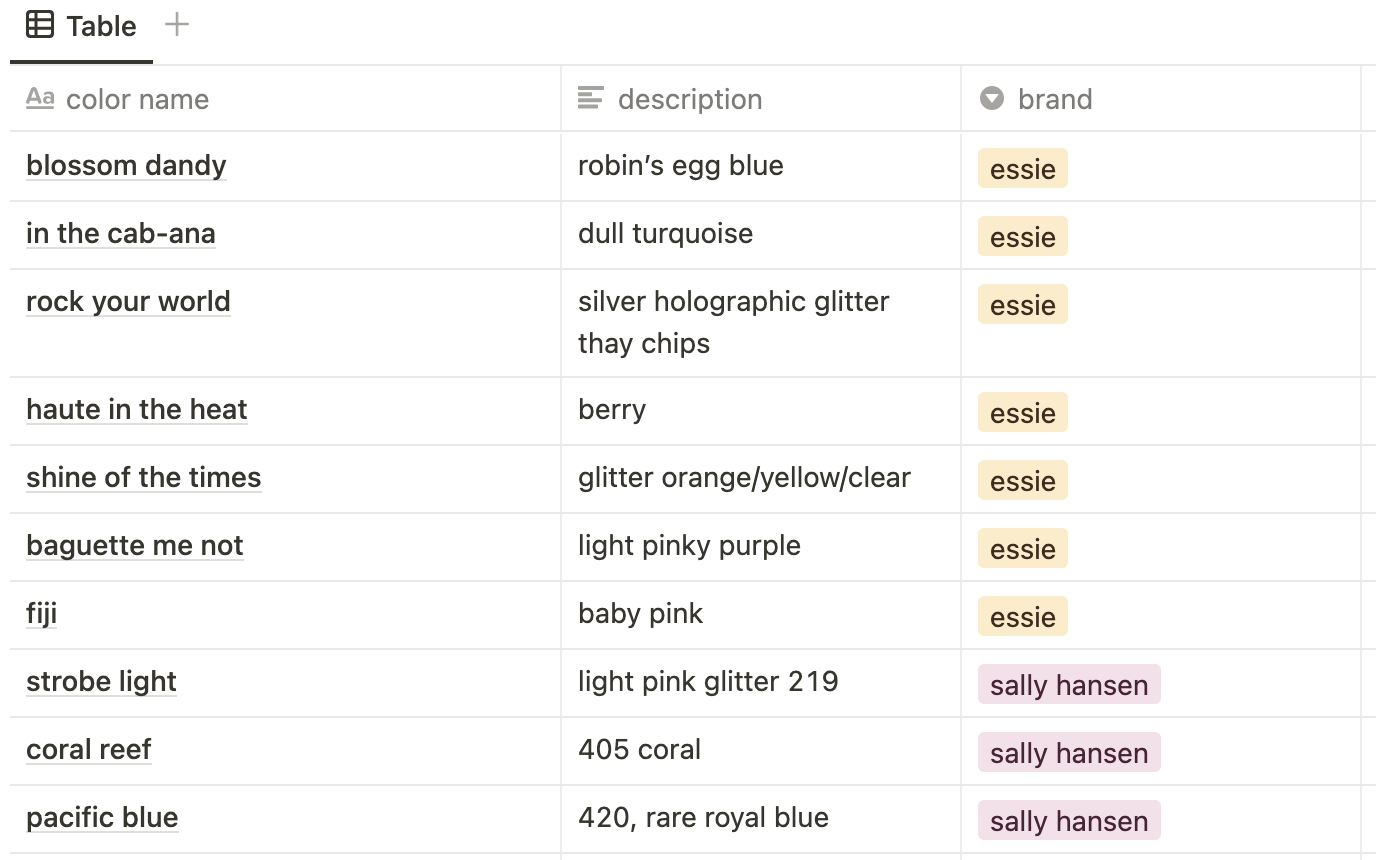
Start with: If you notice yourself accidentally buying doubles of things or forgetting which X item you actually have, start there. For crafters, this might be acrylic paint colors. For some, maybe essential oils or lipsticks. This can also apply to your closet if you keep buying black T-shirts or brown boots.
Elevate it: Make the list a checklist and add on items you wish to have. For example, if you collect copies of “The Great Gatsby” include editions you’re hunting for so you can reference it on your next trip to the bookstore. If you collect nail polish, write down gaps in your collection (no warm-toned reds, for example) or shades you’d like to purchase.
Clothing sizes and measurements
I started this note after the millionth time I measured myself to figure out what size shirt/dress I should be ordering. And once I realized that my jeans size varies wildly from store to store and brand to brand, I made my list even more detailed.
Start with: Take your common measurements — chest, waist, hips. For your go-to stores or brands, add your go-to sizes. Brands can really vary, so note your size in your favorite staples, from J Crew sweaters and Old Navy ones.
Elevate it: Update this regularly. You can also make it more detailed and include the cut or style of jeans you love from brands (especially handy for Levi’s). It’s helpful to break these into categories by garment type and store. You can also add other common handy measurements, like the size of your living room or kitchen table or even the necklace-chain length you like the most.
Wishlist
This is essential if you, like me, are prone to impulse buys fueled by TikTok videos. Wishlists help you simmer on your purchases before you make them — I often end up deleting things from the list because I’ve changed my mind. It also helps you realize what you really want. After I added a walking pad to the list three times, I knew it was time to invest in one.
Plus, if someone is asking what to get you or you want to treat yourself, you won’t have to think too hard about what to choose!
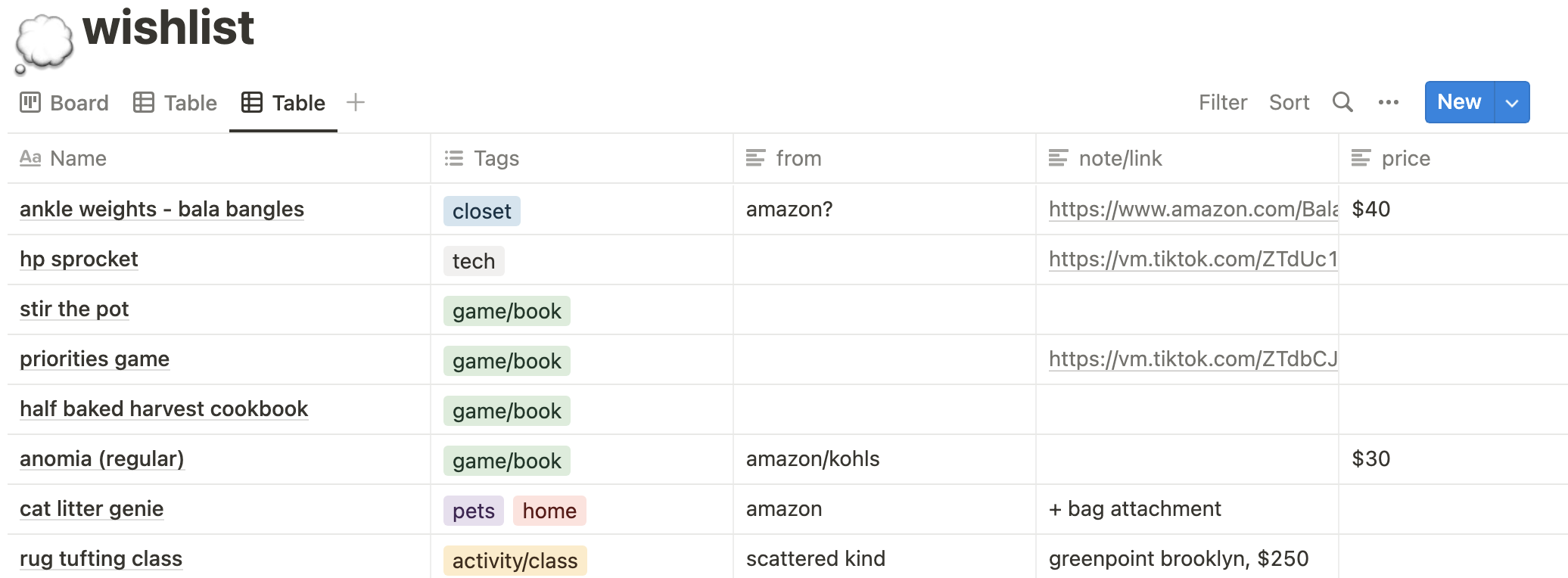
Start with: Whenever you think of something you want or see a tempting TikTok, drop it on the list instead of adding it to your cart. Is there anything you’d like to replace or upgrade? Something you’ve been eyeballing?
Elevate it: Categorize your list! I sort mine by things like home, game/book, activity/class, beauty, closet, pets, tech. I also have a “LOW” or “HIGH” priority tag, which I use for seasonal items, sale items, or things I know I do not need and should think about. It’s also helpful to include prices, links, and other notes (where to buy the item from, what color or size you want, etc).
Gift ideas
This has made birthdays and the holiday season so much less stressful. For a while, I would leave gift ideas in reminders, notes, and documents. Now, I keep them sorted in one place. Many of the best gift ideas come when you least expect them.
Did your friend mention their favorite hometown coffee shop now delivers? Add a bag of their favorite beans to your list. Is your dad super into cooking now but keeps complaining about chopping vegetables? Write down a new chef knife or knife-skills class at the local culinary school.
Start with: When you see a great gift idea or someone in your life does an “Oh my god, this is amazing” in the store without buying anything, write it down. Most of my gift ideas are compiled throughout the year whenever I hear someone talk about how they wish they could buy something or love XYZ thing.
Elevate it: Using Notion, I’ve organized my gift ideas into a table and I categorize gifts by the people they are for. If it’s a gift that could be good for more than one person, like my brother and my boyfriend, I’ll tag them both. When it’s time to buy that person a gift, I can sort by the tag and see all of the ideas meant for them.
A detailed ‘Rolodex’ with thoughtful details about people in your life
I started doing this after I almost lost all of the contacts on my phone. It started with my friends’ phone numbers and addresses.
But, in time, I started adding more information because it’s just so valuable and comes in handy often.
Now, I keep track of things like birthdays, zodiac signs, go-to coffee orders (you never know when they might need a pick-me-up), favorite color, desserts they love (knowing someone’s fave cake flavor is very handy for birthday surprises), and so on. It’s really, really helpful for times when you want to do something sweet or put together a gift.
Start with: Compile your friends’ addresses and phone numbers. As you learn little details that might come in handy later, write them down. This can be super handy for family, too. If a whole list seems ambitious, start by adding things in the “Notes” section of their contact in your phone, which is what I do in a pinch.
Elevate it: Most of the things in this list you can fill out over time without asking. What do they order at the bar or serve you when you come over? Pay attention to what they often get and what they rave about.
It depends on the person, but if it’s someone you buy gifts for it might also be handy to note their clothing/shoe sizes, favorite scents, or allergies they have. This list can also help you when it comes to making your gift ideas list.
List of favorite things
For about eight years, I’ve had a running list of my favorite category of just about everything, from scents to names, that I keep on a Google Doc and update regularly.
I reference it constantly. First of all, it’s cool to see how my tastes have evolved over time (I strike out things I don’t love anymore — a lot of YouTubers and snacks have been axed).
It’s also an excellent resource when I’m trying to figure out which Bath & Body Works candle to order online (my fave scents are already compiled for me), and which movies, shows, albums, or podcasts to recommend to friends. It even helps sometimes when I’m trying to figure out where I want to go to dinner.
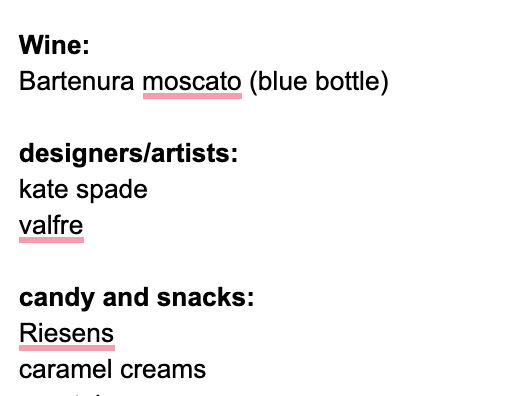
Start with: Pick some categories! What are things you recommend often? Or some of your favorite things, in general? For me, a lot of the categories are based on things I often recommend or need to name (favorite movie or book is a popular ice breaker at most jobs/in many classes) or things I need to purchase.
Elevate it: Keep expanding on categories you can regularly update. Some examples to get you started: Broadway shows/musicals, movies, podcasts, shows, scents, stores, names, books, snacks, celebrities, animals, restaurants, artists, musicians, albums, comedians, professors, beauty products, TikTok accounts, nail polish, cities I’ve been to, cereals
Things you want to watch
You’ll (almost) never have to worry about figuring out what to put on TV again! You can make your lists/watch later lists across your million streaming apps, but I hate how divided it all is. I also hate trying to find shows or movies.
The most efficient way I’ve found to do this is with the app TV Time. You make massive to-watch lists, and the app tells you when shows are back with new seasons, when their episodes air, and what streaming site you can watch them on. It also lets you track what episode you’re up to. Now, I can watch six shows at once without forgetting about any or where I left off!
Start with: Download the app and start tracking as you watch. I’m not sponsored, I promise. I just love it. It’s the most efficient way to track shows and movies I want to see that I’ve found.
Elevate it: On TV Time, also add shows and movies you’ve already seen, especially your favorites. The app can also recommend shows and movies to you if you need suggestions. I don’t use this feature much, but it’s pretty neat. You can also keep track of how many times you’ve rewatched something.
Packages or other things you’re waiting for
If you regularly online shop, this list is so important. I started this after I ordered a few packages that never arrived. They never came and I fully forgot I was supposed to get them until I noticed them on my credit card bill.
Start with: When you order a package, write down the store it’s coming from in your Notes app. My note is called “Waiting.” Regularly check this list so you know if you need to look into an order and make a call or cancel one you placed months ago.
Elevate it: Also use this to track packages or returns you ship. Note the day you mailed them and even include your shipping receipt/tracking number. You can also include the date you’re supposed to get something or which carrier should be shipping it. This is also handy if you preorder books, games, or other items that may not arrive for a while.
Reusable packing list
Most of my packing lists are more or less the same. They only really vary by temperature or quantity. By creating a usual base list on Notion (Notes app works, too), I am less likely to forget items.
Start with: Next time you pack, write down what you’re bringing as you pack it. Divide the list into categories — toiletries, clothes, shoes, accessories, and misc. Use this as the base of your list and keep updating as you go.
Elevate it: Make go-to packing lists for a range of common trips, like an overnight stay, weekend trip, cold-weather vacation, beach vacation. Or you can divide lists by how many bags you can pack (carry-on, one suitcase, both).
You can also make a “before I leave” list, which includes things you do before every trip like check doors are locked, empty out fridge, and water plants.
Local restaurants and recommendations
This will be an absolute lifesaver when someone comes to visit you or when you’re trying out where to get dinner. I recommend using Google Maps because you can make lots of different lists and leave notes on your pins.
You can also view lists on a whole or see your pins based on location, which is so helpful for planning. Because of my organized lists, I know no matter where I am in Manhattan I’ll likely be near a restaurant I’ve liked or am dying to try.
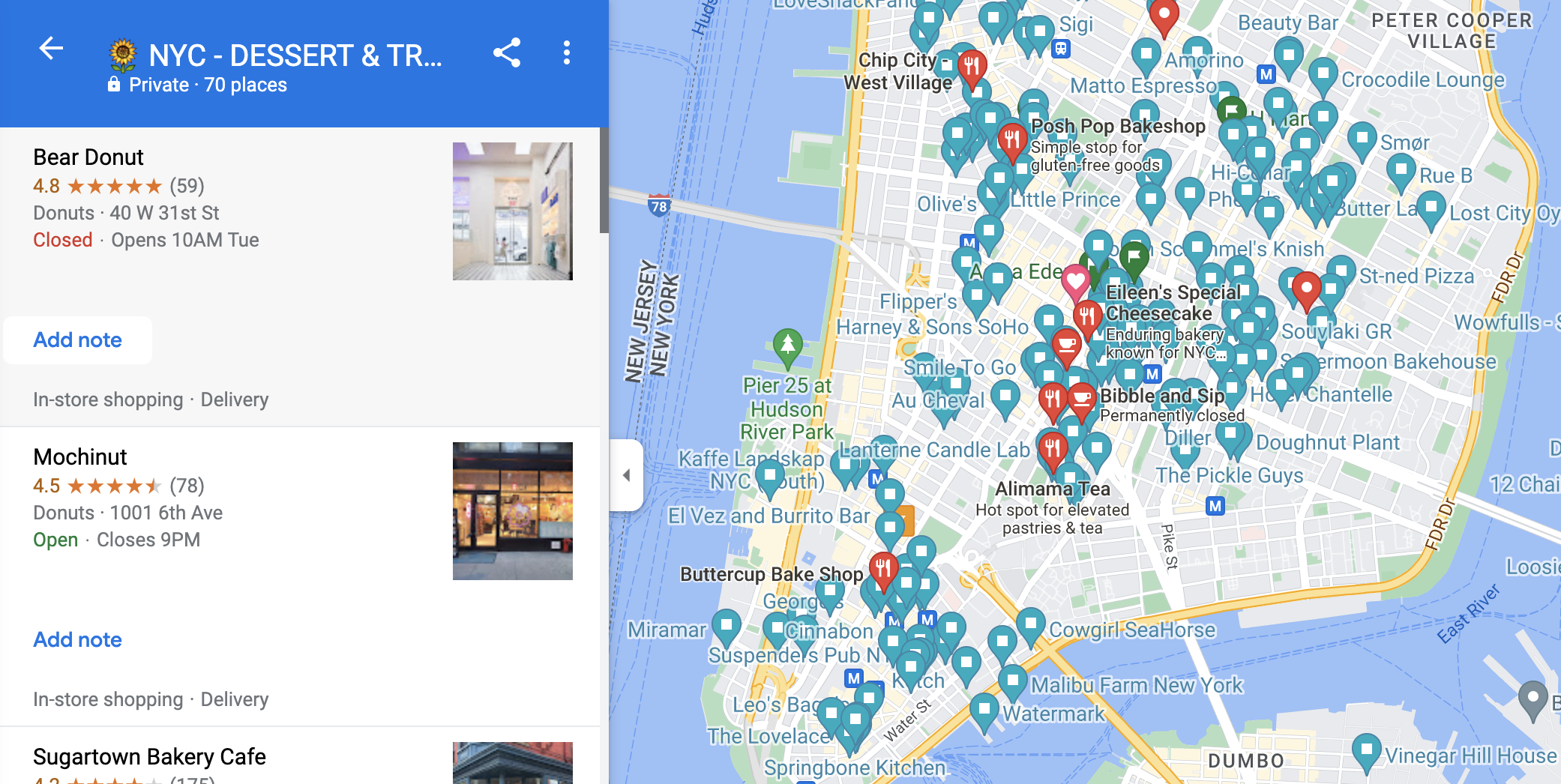
Start with: Pin places you love while traveling or visiting new places. You’ll be prepared for next time or able to easily give recommendations to someone else going to that area. It helps to break your lists into categories, too. For example, for places I have been to and go to often (like NYC!) I have expanded my categories — nightlife/bars, cafes/coffee, dessert, dinner, lunch.
I also keep a category where I pin my absolute, five-star favorite places for quick reference.
Elevate it: Use the notes section of Google Maps to write down dishes you loved or important reminders on the places you save (ie: “boneless wings were good, burger OK” and “only outdoor seating” and “live music on Tuesdays”). You can also leave reviews of these places which helps other possible customers and helps you remember what you ordered and how you like it (I love doing this).
You can also use your lists to pin wishlist spots — I have lists for New England, Denver, and even other countries. Whenever I see a cool restaurant on TikTok or a blogger going to a store that looks cool, I pin it! That way, if I’m ever nearby, I can check it out.
You can also make your categories even more detailed and personalized — cafes I like working at, outdoor spaces I love, best happy hour deals on Fridays, restaurants I’ve seen on “Real Housewives.”
A lowkey bucket list
I prefer calling this list “things I want to do” because bucket lists sound intense and, honestly, most of the things on this list are quite doable. I made this because I had waaaay too many reminders going off to remind me that I wanted to do the cider tasting at Angry Orchard, visit the food festival nearby, and go to specific seasonal events in NYC.
Start with: When you think of a class you want to take, an event you want to attend, or other experience you want to have, write it on the list. This can be specific or vague. Some of the items on my list, for example, are to take a cooking class at Hudson Table, take a knife skills class, go to Brooklyn Flea, go to the Dominique Ansel pie-tasting event, and make pottery.
Elevate it: Add more detail to your list and some actionable items. Are some of these events seasonal? Do multiple take place in the area and can you plan a weekend trip around checking them off? Would some of these be good gift ideas or something fun to do with a friend?
It might also be worth dividing this list into seasons or adding specific dates if needed. Some events, like the Dominique Ansel pie event, only happen once a year so I need to plan ahead. I’ve set reminders on my phone to go off around the time tickets tend to go on sale.
I also knew I wanted to go to an Angry Orchard tasting with friends in the fall, so I set a reminder to go off in August so we could compare calendars and buy tickets before they sold out.
Books you want to read
This might not apply to all, but I don’t know what I’d do without Goodreads. I love reviewing and tracking books I’ve read and I have hundreds of books on my want-to-read list. It’s so helpful if I’m in a reading slump.
Start with: Make a Goodreads account or just make a list or use another site for tracking. Whenever you hear about a book or receive a recommendation, mark it down! Your list will grow in no time.
Elevate it: Organize your want-to-read list by genre or by season (I love a rom-com in the summer and winter and thrillers in the fall). Expand your shelves by making one for your favorite memoirs or non-fiction books. Make a list of books you want to finish by the end of the year or try a challenge, like reading one book by an author from every letter of the alphabet.
Ideas for future parties, dates, wedding, etc
This one can vary a lot depending on if you enjoy planning things and what events may be in your future. I started this after my boyfriend and I attended a bunch of weddings in a row. I realized that we’d often spend the car rides home talking about little touches we loved and would love to do for our own someday (custom cocktails) and things we would definitely not want (a DJ who tries to make guests play games).
I also add ideas I find from TikTok. I know it’ll come in handy someday when I’m planning a wedding, and I’ve already shared it with a friend of a friend who is. I also keep lists of more general theme party ideas or fun touches, like drinking games and finger food ideas.

Start with: Next time you go to a party, write down some of the things you loved and things you didn’t. Was the dance floor PACKED when they played “Mr. Brightside” so you want it on your list but you felt there were far too many slow dances? Did you love the location your friend chose for her birthday? Play a really fun party game recently? Write it down!
Elevate it: Pinterest can be really useful for these ideas if you’re an especially visual person. You can also sort your list into categories, like games, decor, food, drinks, music, outfits, and more. You already know I have wedding Pinterest boards broken into categories. One of my boards even helped me figure out which engagement ring I truly want because I had, over the course of years, saved the same exact ring a minimum of seven times.
Running shopping list
This is so helpful for when you run to the store. It’s also great to make this a shared list if you live with another person.
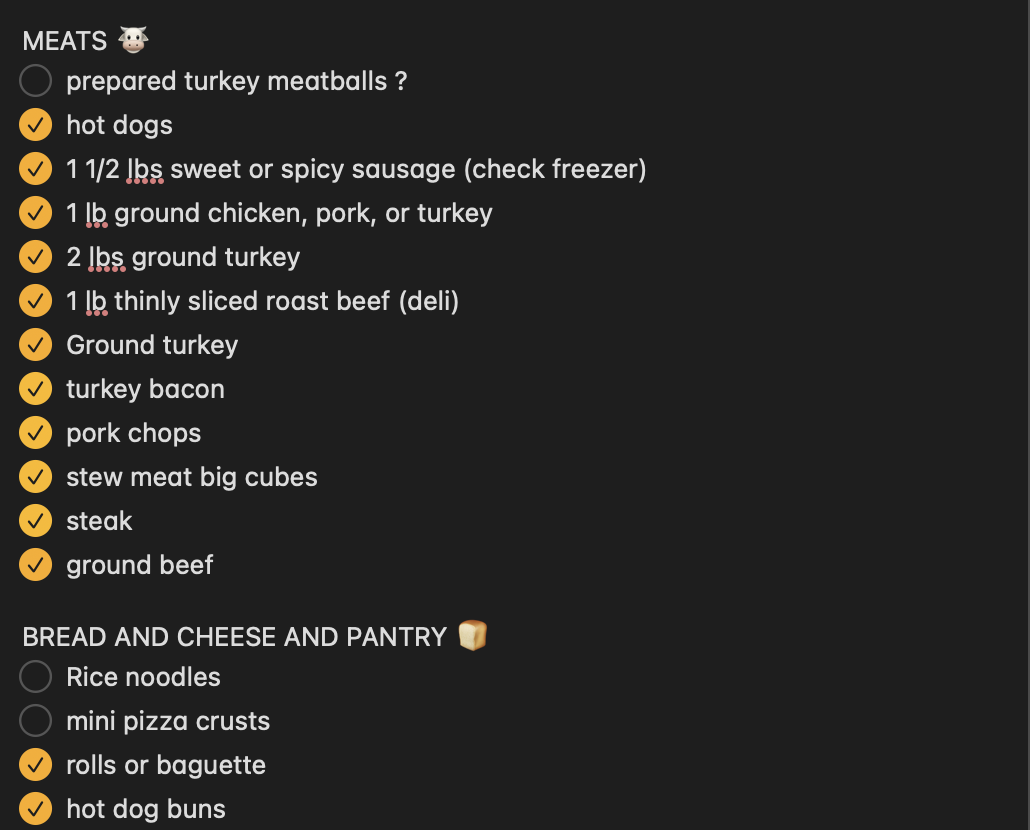
Start with: When you run out of something, write it on your list. If you’re running low on an essential, also write it down. It’s also helpful to reference checked-off items when you’re not sure which groceries to buy or what you regularly use up.
Elevate it: Break your lists into categories (dairy, frozen, produce) and break it down by stores (Shop Rite, BJ’s and Costco, Asian market). You can also use this list for priority wishlist items. For example, take note if you’re looking for the perfect black tablecloth or plum lip gloss.
General useful info for your household and health
This is sort of like the junk drawer of lists. It’s got loads of helpful stuff, but it can be messy. It helps if you make this on a platform that’s searchable because you can just type whatever keyword you need.
Start with: What are things you look up often or often need to reference? Start your brain dump and add to it as you go.
Some ideas: How long your apartment building’s washing machine and dryer take to run a basic cycle, when you last went to the dentist, the name of prescriptions you take, your car’s license plate number, where you’ve stored your Christmas decorations, the go-to brand/flavors of pet food you buy your cat, the Wi-Fi password for your place and your parent’s house, which button you need to press to reset the router properly.
Elevate it: Keep track of clever names for your bar trivia team (it’s hard to think of names on the spot). Throw in important dates that are reminders in and of themselves — when you last trimmed your cat’s claws, replaced your toothbrush, or cleaned the toilet.
Things you want to master (meals, skills, etc)
This is another list that can really range. My current one is centered on cooking after I got to thinking about which recipes every good home cook should have.
What are truly staples? I’ve already mastered some go-to great recipes for macaroni and cheese, burgers, bolognese, and vodka sauce (thanks, grandma!). Some dishes on my to-master list are chicken noodle soup (a go-to for this would be killer) and pizza.
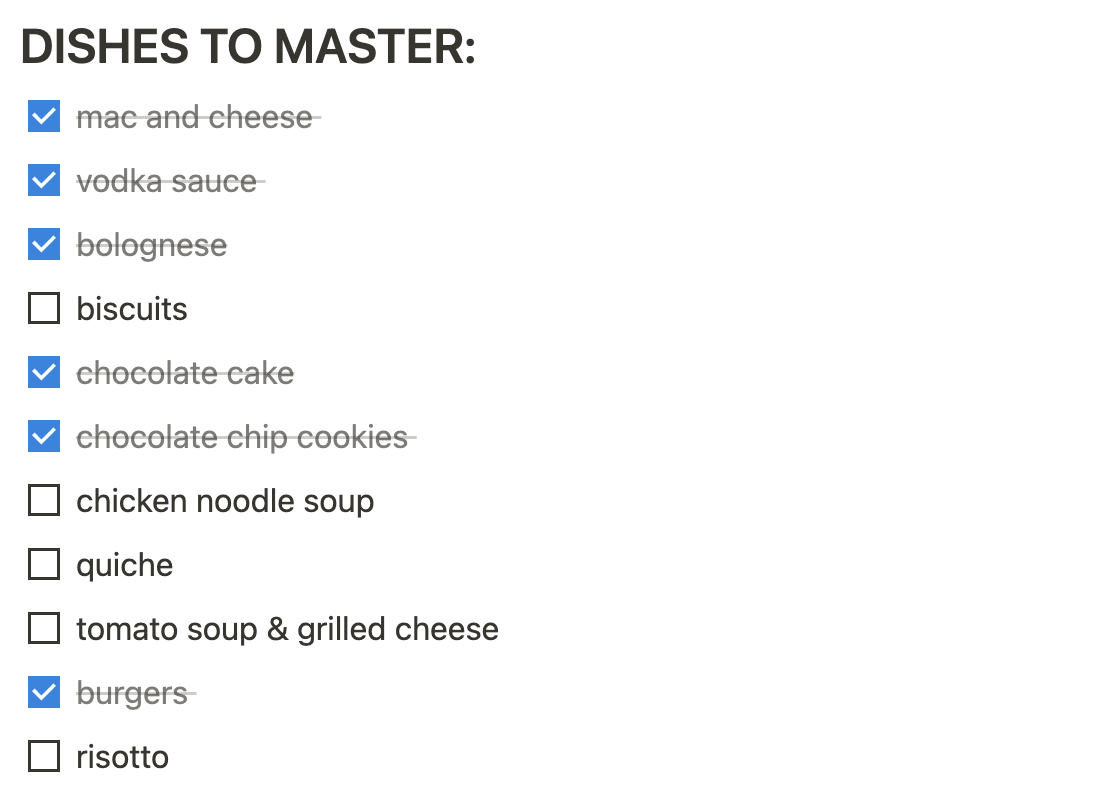
Start with: Think about things you want to get better at or work on, and think of your hobbies and interests. Do you want to master or attempt to write a short story from four different genres this year? Learn how to do more different nail art or painting styles? Do you want to create go-to workouts for each part of your body that you can eventually cycle through each week?
Elevate it: Make the list actionable or more detailed. If you want to create killer leg, arm, and glute days, round up YouTube workouts and moves you love and experiment. If you want to master baking certain dishes, check out some cookbooks from the library or start researching recipes.
Running to-do list
Even though you’ll swear you’ll remember you need to do something, you just might not. Items on the running list can range from unnecessary items that’d be nice or necessary things you must do.
Start with: Brain dump everything that is currently on your plate. Are there things you need to fix or redo? Do you need to get a haircut or schedule a follow-up dentist appointment? Are you hoping to create a budget tracker for yourself? Does your dog need to be groomed? Do you want to go through your closet and make a donate pile now that the seasons have changed?
Elevate it: Rank it by priority. Things with deadlines (ie: hem dress before the wedding on June 12, submit calc assignment by Friday) and things with consequences (laundry — if you don’t do it you won’t have clothes, pay electric bill — you won’t have power) should go on top. Miscellaneous things, like making appointments or fixing a low-stakes chip on your wall can probably be lower.
If it helps, create a power hour or day of completing low-stakes items on your list. It’ll feel great to check them off and sometimes it’s hardest to do lower-stakes things you could technically do anytime.
People I need to answer or reach out to
I mostly use this for emails, which may not apply to every job. Still, it might apply to your side hustle — or, this might work for you if you’re a bad texter. Or not so great at keeping in touch with long-distance friends and family.
I like to make a list of this almost every day because my job consists of so many emails. I usually write it on paper and keep it near my computer. It serves as a checklist.
Start with: Scroll through your emails and to-do lists, then write down who you need to answer or just messages you need to send. You can sort the list by ASAP, by end of week, or by end of month, too.
Elevate it: Make email templates for commonly sent messages. I recently discovered this basic feature in Gmail and it’s saved me a lot of time! They’re easy to edit and you can make quite a few.
Think of emails you’re tired of typing out or ones you send really often. Is it the answer to a commonly asked question? An email you use to collect data from clients? A welcome/introduction email you always use?






